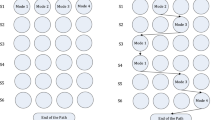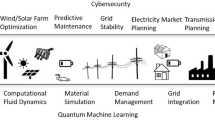Abstract
We utilize a competitive coevolutionary algorithm (CA) in order to optimize the parameter set of a Fuzzy-System for job negotiation between Community-Grids. In a Community-Grid, users are submitting jobs to their local High Performance Computing (HPC) sites over time. Now, we assume that Community-Grids are interconnected such that the exchange of jobs becomes possible: Each Community strives for minimizing the response time for their own members by trying to distribute workload to other communities in the Grid environment. For negotiation purpose, a Fuzzy-System is used to steer each site’s decisions whether to distribute or accept workload in a beneficial, yet egoistic direction. In such a system, it is essential that communities can only benefit if the workload is equitably (not necessarily equally) portioned among all participants. That is, if one community egoistically refuses to execute foreign jobs regularly, other HPC sites suffer from overloading. This, on the long run, deteriorates the opportunity to utilize them for job delegation. Thus, the egoistic community will degrade its own average performance. This scenario is particularly suited for the application of a competitive CA: the Fuzzy-Systems of the participating communities are modeled as species, which evolve in different populations while having to compete within the commonly shared ecosystem. Using real workload traces and Grid setups, we show that the opportunistic cooperation leads to significant improvements for both each community and the overall system.







Similar content being viewed by others
Notes
Multiple populations can also be used in ordinary evolution which are then called island models or species niching.
In contrast to the common notation, we denote the mean of the GMF by γ to avoid conflicts with the parental population size of evolution strategies which we denote by μ.
References
Akbarzadeh MR, Mosavat I, Abbasi S (2003) Friendship modeling for cooperative co-evolutionary fuzzy systems: a hybrid GA-GP algorithm. In: 22nd International conference of the North American fuzzy information processing society, pp 61–66
Casillas J, Cordón O, Herrera F, Guervós JJM (2002) Cooperative coevolution for learning fuzzy rule-based systems. In: Selected papers from the 5th European conference on artificial evolution. Springer, London, pp. 311–322
Cordon O, del Jesus M-J, Herrera F (1999) A proposal on reasoning methods in fuzzy rule-based classification systems. Int J Approx Reason 20(1):21–45
Cordon O, Gomide FAC, Herrera F, Hoffmann F, Magdalena L (2004) Ten years of genetic fuzzy systems: current framework and new trends. Fuzzy Sets Syst 141(1):5–31
Delgado MR, Von Zuben F, Gomide F (2004) Coevolutionary genetic fuzzy systems: a hierarchical collaborative approach. Fuzzy Sets Syst 141(1):89–106
Donato JM, Barbieri E (1995) Mathematical representation of fuzzy membership functions. In: Proceedings of the 27th southeastern symposium on system theory. IEEE Computer Society, Washington, DC, USA, pp 290
Ernemann C, Hamscher V, Yahyapour R (2004) Benefits of global grid computing for job scheduling. In: Proceedings of the fifth IEEE/ACM international workshop on grid computing (GRID’04). IEEE Computer Society, pp 374–379
Foelling A, Grimme C, Lepping J, Papaspyrou A (2009) Co-evolving fuzzy rule sets for job exchange in computational grids. In: Proceedings of the 2009 IEEE international conference on fuzzy systems. IEEE Press, NJ, pp 1683–1688
Franke C, Hoffmann F, Lepping J, Schwiegelshohn U (2008) Development of scheduling strategies with genetic fuzzy systems. Appl Soft Comput 8(1):706–721
Grimme C, Langhammer T, Papaspyrou A, Schintke F (2007a) Negotiation-based choreography of data-intensive applications in the C3Grid Project. In: Proceedings of the German e-Science Conference (GES), Baden-Baden, Germany. Max-Planck Society (online)
Grimme C, Lepping J, Papaspyrou A (2007b) Exploring the behavior of building blocks for multi-objective variation operator design using predator–prey dynamics. In: Thierens D et al. (eds) Prococeedings of the genetic and evolutionary computation conference (GECCO 2007). ACM Press, London, pp 805–812
Herrera F (2005) Genetic fuzzy systems: status, critical considerations and future directions. Int J Comput Intell Res 1(1):5–31
Herrera F (2008) Genetic fuzzy systems: taxonomy, current research trends and prospects. Evol Intell 1(1):27–46
Hillis WD (1990) Co-evolving parasites improve simulated evolution as an optimization procedure. Phys D 42(1–3):228–234
Ishibuchi H, Nakashima T, Morisawa T (1999) Voting in fuzzy rule-based systems for pattern classification problems. Fuzzy Sets Syst 103(2):223–238
Juang C-F, Lin J-Y, Lin C-T (2000) Genetic reinforcement learning through symbiotic evolution for fuzzy controller design. IEEE Trans Syst Man Cybern 30(2):290–302
Nejad SK, Najafi-Ardabili A, Akbarzadeh-T MR, Moeinzadeh M-H (2008) A co-evolutionary fuzzy system for real-time signal pre-processing. in: Asia international conference on modelling and simulation, pp 620–624
Olsson B (2001) Co-evolutionary search in asymmetric spaces. Inf Sci 133(3–4):103–125
Paredis J (1995) Coevolutionary computation. Artif Life 2(4):355–375
Paredis J (2000) Evolutionary computation 2: advanced algorithms and operators, chapter coevolutionary Algorithms. Institute of Physics Publishing, Bristol, pp 224–238
Peña-Reyes CA, Sipper M (2001) Fuzzy CoCo: a cooperative-coevolutionary approach to fuzzy modeling. IEEE Trans Fuzzy Syst 9(5):727–737
Potter MA, De Jong KA (2000) Cooperative coevolution: An architecture for evolving coadapted subcomponents. Evol Comp 8(1):1–29
Rosin CD, Belew RK (1997) New methods for competitive coevolution. Evol Comput 5(1):1–29
Schwefel H-P (1995) Evolution and optimum seeking. Wiley, New York
Schwiegelshohn U, Yahyapour R (1998) Analysis of first-come-first-serve parallel job scheduling. In: Proceedings of the 9th SIAM symposium on discrete algorithms (SODA98). SIAM, Philadelphia, pp 629–638
Schwiegelshohn U, Yahyapour R (2000) Fairness in parallel job scheduling. J Sched 3(5):297–320
Smarr L (2004) Grids in context. In: The grid: blueprint for a future computing infrastructure, 2nd edn. Morgan Kaufman, San Francisco, pp 3–12
Smith SF (1980) A learning system based on genetic adaptive algorithms. PhD thesis, Department of Computer Science, University of Pittsburgh
Walter I, Gomide F (2009) Multiagent coevolutionary genetic fuzzy system to develop bidding strategies in electricity markets: computational economics to assess mechanism design. Evol Intell 2:53–71
Author information
Authors and Affiliations
Corresponding author
Rights and permissions
About this article
Cite this article
Fölling, A., Grimme, C., Lepping, J. et al. Connecting Community-Grids by supporting job negotiation with coevolutionary Fuzzy-Systems. Soft Comput 15, 2375–2387 (2011). https://doi.org/10.1007/s00500-010-0667-y
Published:
Issue Date:
DOI: https://doi.org/10.1007/s00500-010-0667-y




